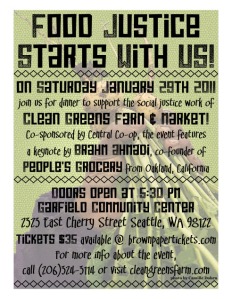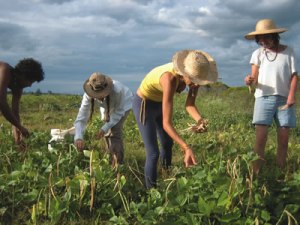
Caitlyn Gilman bubbles over at the Grand Opening of the Seattle Community Farm
We held the Grand Opening of the new Seattle Community Farm this past Saturday, June 25th. OK, that is such a blasé sentence, inadequate to convey the buoyant sense of hope and possibility that was in the air as surely as crops to feed a hungry community are about to break forth from the Farm.
The words “grand” and “opening” are so overused, conjuring images of chain stores popping up like weeds, nothing more grand than asphalt, nor more open than your wallet. But if we stop for a second to really consider these what these words mean, we’ll get a better sense of the what was going on this lovely afternoon.

Lettuce Link Program Manager Michelle Bates-Benetua
A third of an acre of neatly contoured garden beds, the Seattle Community Farm runs in a narrow strip from Andover to Lilac streets, a stone’s throw from the Link Light Rail tracks on MLK Jr Way S, snug up against the hindquarters of Beacon Hill.
While the size might hardly seem grand, the design of the farm certainly is!

Aidan Murphy and Caitlyn Gilman paint worm bins
Borne of the growing urban agriculture renaissance and shepherded by Solid Ground’s Lettuce Link program, the project has turned a neglected strip of defacto parking lot into a model for how we can nourish a community.
The Farm has drawn in the resources of the City of Seattle’s Department of Neighborhoods, the Seattle Housing Authority (who owns the land), the US Department of Agriculture (which provided startup funds for the project), residents of the Rainier Vista housing development and Rainier Valley communities, local designers, artists, AmeriCorps teams and many others.

Landscape designer Eric Higbee and scarecrows
Through months of hard labor, the land has been transformed. Literally tons of rock for walls and structures, sand for drainage and topsoil were moved and sculpted into 90 loamy garden beds, a children’s garden, and a community gathering space. The site was designed by landscape architect Eric Higbee with input from the neighborhood.

Scott Behmer's office is cooler than yours!
Its transformation was overseen by Farm Coordinator Scott Behmer, whose office in the corner of the large tool shed (built by volunteers from the adjacent Habitat for Humanity build site) is truly a room with a view, with an open window surveying the property.

Baby broccoli
All but one of the beds is planted, and while our dreary spring has dampened the progress, there are so many seeds germinating and starts rooting that you can practically hear the chard, beets, tomatoes and myriad other crops shooting from the soil and reaching for the sky. The land is vibrating with potential! A few weeks from now it will be a riot of organic produce, the grand outcome of sunshine, healthy soil, water and caring human hands.

Seattle City Council President Richard Conlin and guests
As for opening: In this newly created Rainier Vista neighborhood, the Farm represents a truly open social experiment. It is a vessel of opportunity to be filled by the volunteer contributions of people who have come to the Rainier Valley from all around the world. At the grand opening alone, among the 100 or so guests were community members whose gardening experience started in East Africa, the Pacific Islands, Mexico, the Middle East and even the Midwestern US.

Many hands make light work!
Through a developing work trade model, neighbors who volunteer will receive a bag of fresh produce for every two hours of work, giving people living on low-incomes direct access to the healthiest organic produce possible.
Produce not taken through the work trade model will be delivered to the nearby Rainier Valley food bank for distribution to the broader community.

The Farm!
The model is open and evolving to meet the neighbors’ needs and interests, gleaned through a series of community outreach meetings that brought people from many cultures and lands together over food, language translators and the desire to eat more healthful food.

AmeriCorps member Mariah Pepper leads a farm tour
The event this weekend featured a few guest speakers, Seattle City Council President Richard Conlin and Department of Neighborhoods’ Bernie Matsuno, but the real stars of the show were the men and women from the community. When the speeches were done they walked through the rows, knowingly eyeing the nascent crop, excited voices in languages I could not even identify, hands pointing with passion at the healthy future to come.
Filed under: Food & Nutrition | Tagged: food security, Lettuce Link, Rainier Vista, Seattle Community Farm, sustainable agriculture, urban ag | 1 Comment »
 They harvest the veggies themselves – chard, sweet peas, carrots, broccoli – and help prepare a snack especially for them. Today, it’s Chinese Veggies and Rice, and it’s a hit.
They harvest the veggies themselves – chard, sweet peas, carrots, broccoli – and help prepare a snack especially for them. Today, it’s Chinese Veggies and Rice, and it’s a hit.




















